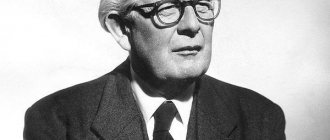Ego identity is your image of yourself in relation to the world. He answers the questions: “Who am I?”, “What am I like?”, “What is my place in the world?”
Erikson's theory emphasizes that in addition to instincts and needs, the sociocultural environment in which a person grows has a direct impact on the formation of the Ego. How does this happen? And why is it so important to find identity with yourself?
In this article:
What is Ego-identityStages of formation of Ego-identityEgo-integration and identity crisis
What does "ego" mean?
First you need to understand what the ego is. This term is most often used in psychoanalysis. The ego is the inner essence of a person, responsible for perception, memorization, contacts with society and evaluation of the world around us. This helps a person to separate himself from everything else, to accept himself as an independent and individual being.
Is ego good or bad?
The human ego is an important component of personality structure. Without it, the existence of man as such is impossible. It does not matter whether the Ego is male or female, it helps to perceive the external world and analyze it from the point of view of importance for a person. Thanks to the inner “I”, each individual adapts to the world, finds his place and calling, and comes into contact with the people around him.
Whether it is good or bad to have your own Ego can only be discussed from the perspective of the level of development of this substance and the dominant functions it has assumed. If the world around us is perceived only as a platform for satisfying our own needs, then we can say that the Ego is developed at a weak level. A highly developed “I” strives to be part of the world, therefore it takes into account not only personal interests, but also the interests of others.
Definitions of identity
In psychology, ego identity is a multifaceted concept. When talking about it, the concepts of identity and identification are also mentioned. Thus, B. G. Meshcheryakov and V. P. Zinchenko in the “Psychological Dictionary” propose to consider the following definitions.
- Regarding cognitive processes, this is the establishment of the identity of an object, its recognition.
- From the point of view of psychoanalysis, identity is a process built on the basis of emotional connections. Thanks to them, a person acts as if he is the person with whom he compares himself.
- In social psychology, identification is the process of identifying oneself with another person.
- This is imagining oneself as a fictional character, which results in a deeper understanding of the work of art.
- This is the attribution of one's thoughts, motives, feelings and traits to another person.
- This is one of the types of psychological defense, which consists of unconsciously assimilating something that causes anxiety or fear.
- According to the theory of “Self-concept”, group ego identity is an identity in which a person identifies himself with a social group, large or small community, accepting its goals and values, considering himself a member.
- Identity is also the property of the psyche to express the idea of belonging to various national, linguistic, racial, social, religious, economic, political, professional and other groups that have certain properties.
Thus, a general definition can be formulated. In psychology, ego identity is the continuity and identity of the “I”, the integrity of the personality, which is preserved despite the changes that occur in the process of its development and growth. That is, as a person grows older, he understands that he remains the same, himself.
Ego Defense Mechanisms
The founder of the theory of defense mechanisms is S. Freud. In scientific works, he spoke about defense mechanisms as a means of protecting the psyche from the pressure of the Id and Super-Ego. These mechanisms work at the subconscious level and lead to a distortion of reality. Freud identified the following ego defenses:
- repression – removal from memory of information that traumatizes the psyche or is unpleasant;
- projection - transferring thoughts and desires to another person;
- replacement - transferring a negative reaction from one person who caused the reaction to another;
- rationalization - explaining unacceptable behavior from a logical point of view in such a way that the behavior begins to seem acceptable or the only possible one;
- regression - a return to behavior characteristic of a younger age;
- sublimation – redirection of impulses that cause discomfort into socially approved activities;
- reactive formation is a manifestation of behavior that is directly opposite to the desires that a person has;
- Denial – refusal to acknowledge unpleasant events or thoughts.
E. Erickson's concept
In general, the term “ego identity” itself was introduced into science by the German psychologist Erik Erikson. Based on Freud's theories, he developed his own concept, which had significant differences. Attention was focused on age periods.
According to Erikson, the ego's job is to ensure the normal development of the personality. “I” is capable of self-improvement throughout life, helping to cope with internal conflicts and correcting the incorrect formation of the psyche. Although Erickson views the ego as a separate substance, he at the same time believes that it is inextricably linked with the social and somatic part of the personality.
The scientist in his theory pays special attention to the period of childhood. This period of time allows a person to develop mentally and get a good start for further self-improvement. Erikson believes that there is a significant flaw in the childhood period. This is a baggage of irrational fears, anxieties and experiences that directly affect the quality of subsequent development.
The main concept in the theory is ego identity, in other words, the integrity of the individual. Its formation begins from birth and continues throughout life, right up to the death of a person. Erikson identifies a total of eight stages of psychosocial development. If a person passes them successfully, a full-fledged functional personality is formed.
Each stage is accompanied by a crisis. By it, Erikson understands the moment that arises as a consequence of achieving a certain stage of psychological maturity and the accompanying social demands that are put forward to the individual at one or another phase of development. An ego identity crisis is the risk of losing it. If the conflict is not resolved, the ego is injured and harmed. Then identity, integrity and belief in one’s own social role decrease or even disappear. But there is also a positive component to the crisis. If the conflict is resolved satisfactorily, the ego receives a new positive quality that guarantees healthy personality formation in the future.
That is, it is necessary that the close group and society contribute to the adequate passage of each identity crisis. Only then will a person be able to fully move on to the next phases of self-improvement.
All eight stages will be discussed separately below. These are infancy, early childhood, play, school age, adolescence, early, middle and late adulthood.
Erik Homburger Erikson – biographical information
The researcher's fate unfolded in an unusual way. Erikson was born in Frankfurt am Main in 1902. In 1928 he began studying psychoanalysis. He was the son of an extramarital affair between Carla Abrahamsen, a Jewish woman from a wealthy family, and a Danish man. Carla's mother died when she was fifteen. Biographers do not have more information about his father. Since Carla was married to a Jew, Waldemar Salomonsen, the child received the surname Salomonsen. Then Erikson's mother became a nurse, moved to the city of Karlsruhe and remarried. Erik Salomonsen became Erik Homburger, who was adopted by her second husband, pediatrician Theodor Homburger. In 1930, Erikson married Joan Serson, a dancer and artist from Canada, and then moved from Europe to America. Finally, Eric Homburger changes his last name to “Erickson” - “adopting himself,” as he jokingly explained it. And Erickson kept his previous surname as his middle name.
Perhaps it was precisely because of his difficult fate that Erikson was so concerned about the issue of identity. As a child, he was not told about his father. In Jewish schools, Erickson was teased by his peers for his blond hair and blue eyes (“Nordic appearance”), and in secular school, for his Judaism. More and more he realized that his father had non-Jewish roots.
After moving to America, the scientist continued his research at Harvard University and then at Yale. From 1960 to 1968, Erickson worked as a professor at Harvard. Erikson was a student of Anna Freud. But Erickson decided to oppose Freud’s theory with his own. The scientist divided human life not into 5, but into 8 stages. He renamed the “genital stage” “Youth”. Erikson also added three more stages related to the period of adulthood. He believed that the influence of personality development on its formation in society is the merit not of subconscious drives, but of the work of the Ego. Erik Erikson is also the originator of the concept of “Ego Psychology.” In it, the Ego is not the servant of unconscious impulses. Erickson was convinced that it was the human Ego that was responsible for organizing life, communicating with people, and personal growth.
Infancy
The formation of ego identity occurs already in infancy. This stage of development conventionally lasts from birth to one year. During this time period, the baby goes through a crisis of basal trust-distrust. If the mother and other close environment during infancy do not provide the child with enough attention, love and care, then he will develop qualities such as suspicion and timidity. Moreover, they will manifest themselves and make themselves felt even during adulthood. If the mother cares enough for the baby and shows love, then he will subsequently begin to trust people and the world as a whole. The environment will be perceived in a positive way. Usually we can talk about a favorable passage of the crisis if the child calmly tolerates the disappearance of the mother from sight. Because he knows that she will come back again and take care of him.
That is, as an adult, a person will trust or distrust society in the same way as he trusted or distrusted his mother in infancy. However, this quality continues to develop at subsequent stages. For example, when a child witnesses the divorce of constantly conflicting parents, the previously acquired basal trust may be lost.
How to acquire an Ego?
The human ego is born along with the appearance of the individual in this world. During life, it can change direction, degenerating from the selfish Self into the higher one. The male and female Ego demands the attention of the whole world, since it considers itself the center of the Universe. Religions of different nations agree that it is almost impossible to overcome the innate selfish Ego on your own. It can only be dealt with with the help of supernatural divine power. You can acquire a higher self through constant spiritual practices, reading spiritual literature and self-improvement.
Early childhood
Lasts from one to three years. At this stage, the crisis moment of ego identity manifests itself in the formation of autonomy or doubt and shame.
In early childhood, the baby develops mental and motor needs that promote independence. The child learns to walk, master the subject environment and do everything without anyone’s help. If parents give such an opportunity, providing freedom, then the child’s confidence is strengthened that he controls himself, his impulses, muscles and environment. So he gradually becomes independent.
Sometimes adults are in a hurry and try to do for a child something that he himself could handle perfectly well without their help. As a result, the child develops such qualities as indecisiveness and shyness. Naturally, they negatively affect later life. Therefore, it is important for parents to be patient and give the child the opportunity to do something on his own.
Use in economics
Elements of a brand’s identity are its attributes (Brand Identify). For example, a brand signature (English Brand Signature): symbol (English Brand Mark), logo (English Brand Logotype), brand slogan (English Brandline or English Brand Slogan), graphics supporting the brand (English Supergraphic).
Brand identity - (eng. Brand Identity). Distinctive features of the brand, its individuality (Brand Personality). The metaphor of brand identity is the “DNA” of the brand. It has several definitions: 1) the strategic concept of the brand’s personality, its external expression, the totality of its identifiers; reflection of characteristics unique to the brand that motivate the buyer; plays a key role in the process of brand recognition by consumers; forms its uniqueness; is the main element of the motivational vertical of brand management, participating in the formation of the brand model and image; 2) what the brand represents in the perception of consumers or as intended by its developers. There is a term “brand attributes” (English: Brand Identify or english: Brand Attributes).
Corporate identity - (English Сorporate Identity), expressed in the attributes of corporate style (English Сorporate style). Same as brand identity, but in relation to a corporate brand. A corporate brand is associated with the company name (and/or its symbol) and can be used for the company's products. It is often the basis or complement for a family brand (English Family Brand) and individual brand (English Individual Brand); In the Asian model of brand management, the corporate brand plays a central role: most subsidiaries, products and services have one brand, which may change, but only slightly. T.N. Monolithic brand or Branded House
In this case, advertising focuses not on product brands, but on the corporate brand: the main advantage is focusing activities on the unity of the company and common corporate values, which in turn allows you to quickly build a global business structure, but is associated with various risks and difficulties during diversification production. In the Western model of brand management, the emphasis is on brands owned by the company, and the corporate brand is assigned a supporting role in the event of the success of products/product categories under independent brands (English: House of Brand)
The modern brand management model uses a combined approach that takes advantage of Asian and Western models. There is also the concept of corporate branding.
National identity - (English National Identity, see Territorial identity). The concept of related sciences in brand management is associated with the terms “national branding”, “territorial branding” or “territory branding” (Wally Olins). Denotes the identity of a national or territorial (regional, country, etc.) brand. For more information, see Brand Identity and National or Territorial Co-Branding.
"Game Age"
Lasts approximately three to six years. During this period, the formation of ego identity can take the path of initiative or guilt.
At preschool age, children usually already do a lot on their own, show enterprise and activity, and strive to communicate with a wide range of people. If parents encourage this, do not interfere with fantasizing and answer the child’s endless questions, then he will go through an identity crisis favorably at this stage.
If adults constantly pull the child back, forbid him to ask anything, invent anything, and arrange noisy games, then he begins to feel guilty, his own worthlessness and loneliness. Subsequently, this can develop into a pathology, perpetuating passivity, psychopathic behavior and even frigidity (or impotence) in the child. Children who have not overcome the crisis at this stage become dependent, driven, and indecisive. They cannot stand up for themselves and do not strive for anything.
School age
This stage is conventionally equated to the age of 6-12 years. At this stage of their life, children begin to learn, try handicrafts, design and build something. They often fantasize about different professions.
Here, the favorable development of ego identity presupposes the presence of social approval. If a child is praised for creativity and activity, this will help develop abilities and become hardworking. If parents and teachers do not do this, then this will contribute to the formation of inferiority. At this stage, the student’s identity can be represented by the phrase: “I am what I was able to learn.”
period of youth
He is aged 12-19 years. This is a time of active physiological changes, striving to find your own philosophy of life and look at the world around you in your own way. The teenager begins to ask questions such as “who am I?”, “who do I want to become?”
The most complete form of ego identity is formed at the age of 12-19 years. It is also at this stage that the deepest crisis begins. If it cannot be overcome, then role confusion will occur. It can be characterized by restlessness and disorientation in oneself. Therefore, it is important to help a teenager create a consistent and unified image of himself. After all, it was this period that Erikson considered the most central in the development of social and psychological well-being.
Notes
- Wed. also Onto In-se in the terminology of ontopsychology
- Zinchenko V. P., Meshcheryakov B. G.
Psychological Dictionary. - 2nd. - M.: Pedagogika-Press, 1999. - 440 p. — ISBN 5-7155-0720-0. - Litvinov N. N. Brand culture: winning the client’s favor (Brand Manager Handbook). // Brand management. — 2007. — No. 5(36) — pp. 338–343.
- English-Russian explanatory dictionary. Marketing and trade. - M.: Economic School, OLMA-PRESS Education, 2005. - 83 p.
- Rudaya E. A. Fundamentals of brand management. - M.: Aspect Press, 2006.
- Litvinov N. N. Brand strategy of territories. Algorithm for searching for national identity (part 1) // Brand management. - 2010. - No. 4 (53). — pp. 244–255.
- Speech communication: Problems and prospects: Sat. scientific-analytical reviews. M., 1983, p. 192-193.
Early maturity
The age of 20-25 is a kind of gateway to a new adult life, as Erickson himself said. As a rule, during this period people get a profession, date the opposite sex, and sometimes get married.
Whether there will be a failure or a positive outcome at this stage directly depends on the success of completing all previous stages. If the identity crisis is overcome, then a person will be able to take care of another individual, will love and respect him, without fear of losing himself. This is what scientists call achieving closeness (intimacy). If the ego-identity develops unfavorably at this stage, the person isolates himself. He will become lonely, with no one to care for and no one to share his life with.
Ego integration and identity crisis
An identity crisis is expressed in the fact that a person does not know what he wants, how he imagines his life, what he likes, what he is passionate about. He does not feel self-realized or significant.
Often an identity crisis is accompanied by a feeling of loneliness, a high level of anxiety, and self-doubt. A characteristic feature of such a crisis is social fears and problems in communicating with the opposite sex.
The opposite of this is the feeling of ego integration, the highest form of wholeness. It is characterized by the fact that the personality:
- adequately perceives the environment;
- knows how to take from her what she needs;
- successfully copes with difficulties;
- makes informed decisions;
- is in harmony with his emotions and manages them;
- builds healthy relationships;
- strives for self-realization.
Ego integration is the perception of the world as an environment where you can satisfy any of your needs or desires.
This does not mean that everything “falls from the sky” on you. You just have all the necessary qualities and skills to find a solution to a problem or ways to achieve a goal. You are confident in your life path and, looking back at the past, you understand that you do not regret anything.
Average maturity
This is a very broad period that covers the age range from 26 to 64 years. Here, the essence of the crisis is the choice between self-absorption (inertia) and productivity (focus on humanity). In the second case, a person gets a job or does something that allows him to take care of the future of society. If a person remains inert, then he focuses only on himself, on his own comfort, satisfaction of his needs and requirements. It would seem that for the era of global consumption this should be considered the norm. However, having chosen such a pole, a person often feels the meaninglessness of life.
How to pacify your Ego?
The fight against one’s own self is one of the most difficult tasks of every individual. If a person has an Ego inflated by passions, anger, envy, material desires, then he will have to fight long and hard with this part of his personality. The first thing you need to pacify your Ego is the realization that it is selfish, inferior. You should understand where it leads, recognize all your aspirations, desires, motives and motivations. After this, you need to choose a way in which you can work on your Ego. To do this, you can use spiritual practices or psychological programs to work on yourself.
Late maturity
This is the last stage of ego identity development according to Erikson. It lasts from 65 years until death. At this age, old age begins, which is considered the most favorable time for reflection, summing up, analyzing failures and achievements. A person can understand that he did not live his life in vain, he succeeded in everything, and everything suits him. Erickson called this awareness a sense of ego integrity. It can be considered a favorable overcoming of the crisis.
However, some old people are beginning to despair because of the summed up results. They are overcome by a feeling of hopelessness because they have not used all the opportunities or corrected some mistakes. They come to the conclusion that their life was completely meaningless. It is in this situation that people are very afraid of the impending inevitable death. In this case, it’s not too late to rethink everything and do something really necessary and useful.
Books about Ego
A huge amount of information about the inner self is collected in the following books:
- Z. Freud “I and It”
. The book examines the power of the Ego, its meaning and connection with the unconscious and conscious side of the psyche. - A. Freud “Psychology of the Self and Defense Mechanisms”
. In addition to reflections on the components of the psyche, the book contains a detailed description of defense mechanisms. - E. Erikson "Identity and the life cycle"
. The book describes in detail the central concept of Erikson's psychology - identity. - E. Gar
. In his work, the author tried to combine different ideas about the unconscious and his own Ego.
conclusions
Erik Erikson, having developed the concept of Sigmund Freud, developed his own unique theory. It focuses on the formation of a conscious, full-fledged personality. He was also the first to formulate a definition of the term “ego identity.” In psychology, this is the integrity of the individual, which develops from birth to death. It is customary to distinguish eight stages of identity formation, each of which is accompanied by a certain crisis. The success of overcoming them determines whether a person will perceive himself as an integral, full-fledged individual or not. Parental education plays the main role in the formation of this quality. At subsequent stages of development, the environment begins to influence.
Freud and Erikson: theoretical differences
Erikson himself insisted that his concepts were nothing more than a continuation of Freud's psychoanalytic theory. But in fact, he moved so far away from it that in modern science Erikson’s theory is considered separately. What is the difference between the views of Freud and Erikson on personality development, human character and its formation in the process of life?
- Freud gave the main role in personality development to unconscious drives, or Id. He was convinced that it was the conflict between the unconscious and social restrictions that was the cause of all diseases and neuroses. Erikson insisted on the dominant role of the ego, due to which Erikson’s theory was called “Ego psychology.” Freud believed that the Ego is a component that, as if between a rock and a hard place, is trying to reduce the restrictions of society and the drives of the Id. Erickson believed that the ego is a separately functioning system that works with the outside world through perception, thinking, memory and attention.
- Freud's and Erikson's views on the parental role in character formation differ. The development of personality is influenced to a greater extent by the conditions in which a person was born and lives, and the historical era. Erikson came to this conclusion by observing the development of children in different cultures. The scientist was sure that the Ego inevitably develops and changes under the influence of external conditions.
Erikson's theory of personality development differs from Freud's concept in understanding psychosexual conflicts. Freud focused on the influence the unconscious has on human life. He was also convinced that the cause of adult conflicts was unresolved childhood trauma. Erikson, on the contrary, placed the main emphasis on understanding the adult as an individual who can cope with difficulties. His theory is centered on the concept of the Ego with all its virtues, which are revealed in the process of life.











